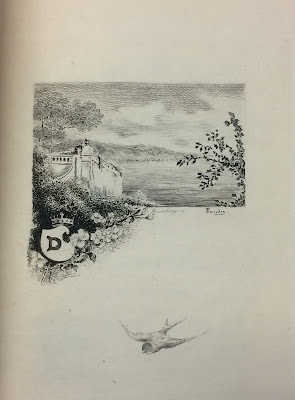Expensive books are like expensive cars, their owners don't like them to be scratched, touched, or sometimes even looked at.
The Sphinx by Oscar Wilde, designed and illustrated by Charles Ricketts, is one of the untouchables. There are dedication copies, and some copies come with bookplates, but rarely more.
However, Dartmouth College Library owns a copy that was extra-illustrated at some point. Extra-illustrated books were a vogue in the eighteenth- and nineteenth-centuries, often so many illustrations from other sources (portraits, topographical prints) were pasted in, that the book's original binding couldn't cope, and new bindings were commissioned to house the complete collection of the original pages and the additional prints.
The Sphinx had ten reproductions after pen drawings by Ricketts. The Dartmouth copy has an original watercolour on the half title.
 |
| Rauner Special Collections Library, Hanover, NH., Rauner Val 826 W64 W6 c.2 Courtesy of Dartmouth College Library |
The illustration shows palm trees, a temple wall, a sphinx, and an incense burner, drawn in black and coloured in blue. There is a signature to the right hand corner of the watercolour. The artist is Frédéric Bourdin, a French illustrator. Not much is known about Bourdin. Between 1911 and 1921 he illustrated books for several publishers.
 |
| Frédéric Bourdin, illustration for Stendhal, La Chartreuse de Parme (1911) copy in the Koopman Collection (KB, National Library of the Netherlands) |
 |
| Frédéric Bourdin, illustration for Stendhal, La Chartreuse de Parme (1911) |
How he came to make an illustration in this copy of The Sphinx is not known.

